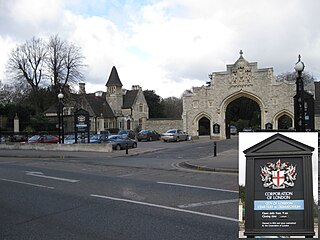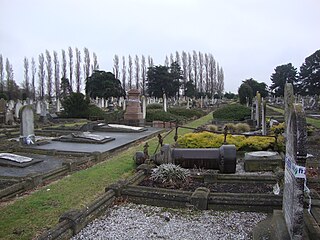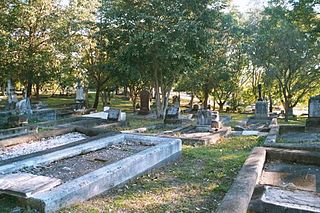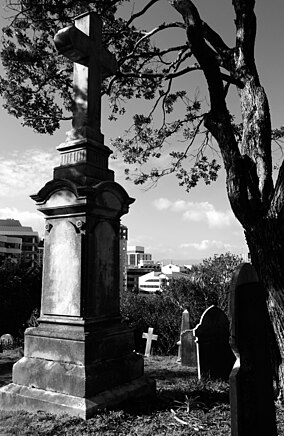
Karori is a suburb located at the western edge of the urban area of Wellington, New Zealand, 4 km from the city centre and is one of New Zealand's biggest suburbs, with a population of over 14,000 at the time of the 2013 census. It is a common misconception that Karori is in fact the most populous suburb in the Wellington region. But Wainuiomata leads with its population of 16,786 at the time of the 2013 census.

Nunhead Cemetery is one of the Magnificent Seven cemeteries in London, England. It is perhaps the least famous and celebrated of them. The cemetery is located in Nunhead in the London Borough of Southwark and was originally known as All Saints' Cemetery. Nunhead Cemetery was consecrated in 1840 and opened by the London Cemetery Company. It is a Local Nature Reserve.

Undercliffe Cemetery is located between Otley Road and Undercliffe Lane in the Bolton and Undercliffe ward, Bradford, West Yorkshire, England. The cemetery stands atop a hillside overlooking the city and contains some very impressive Victorian funerary monuments in a variety of styles. It is a notable example of a Victorian cemetery where a number of rich and prominent local residents have been buried, notably mill owners and former mayors. Undercliffe Cemetery is grade II* listed by English Heritage in their Register of Parks and Gardens of Special Historic Interest in England.

Toowong Cemetery is a heritage-listed cemetery on the corner of Frederick Street and Mt Coot-tha Road, Toowong, City of Brisbane, Queensland, Australia. It was established in 1866 and formally opened in 1875. It is Queensland's largest cemetery and is located on forty-four hectares of land at the corner of Frederick Street and Mount Coot-tha Road approximately four and a half kilometres west of Brisbane. It was previously known as Brisbane General Cemetery. It was added to the Queensland Heritage Register on 31 December 2002.

The cemetery has had various titles including The Cemetery by the Common, Hill Lane Cemetery and is currently known as Southampton Old Cemetery. An Act of Parliament was required in 1843 to acquire the land from Southampton Common. It covers an area of 27 acres (11 ha) and the total number of burials is estimated at 116,800. Currently there are 6 to 8 burials a year to existing family plots.
Margaret Hilda Alington was a New Zealand librarian, historian and author.

Southern Cemetery is a large municipal cemetery in Chorlton-cum-Hardy, Manchester, England, 3 miles (4.8 km) south of the city centre. It opened in 1879 and is owned and administered by Manchester City Council. It is the largest municipal cemetery in the United Kingdom and the second largest in Europe.

The City of London Cemetery and Crematorium is a cemetery and crematorium in the east of London. It is owned and operated by the City of London Corporation. It is designated Grade I on the Historic England National Register of Historic Parks and Gardens.

Alexander Horsburgh Turnbull was a New Zealand merchant, dandy and book collector. On his death, his collection became the nucleus of the Alexander Turnbull Collection, initially housed in his residence, Turnbull House, but as of 1987 housed with the collections of the National Library of New Zealand, a body formed in 1965 by the amalgamation of three libraries, including the one bearing Turnbull's name. In 1913, shortly before his death, Turnbull had presented his Māori and Pacific artefacts to the Dominion Museum.

Thomas Kennedy Macdonald, known as Kennedy Macdonald or Kennedy Mac, was a 19th-century Liberal Party Member of Parliament in Wellington, New Zealand.

The English coastal city of Brighton and Hove, made up of the formerly separate Boroughs of Brighton and Hove in East Sussex, has a wide range of cemeteries throughout its urban area. Many were established in the mid-19th century, a time in which the Victorian "cult of death" encouraged extravagant, expensive memorials set in carefully cultivated landscapes which were even recommended as tourist attractions. Some of the largest, such as the Extra Mural Cemetery and the Brighton and Preston Cemetery, were set in particularly impressive natural landscapes. Brighton and Hove City Council, the local authority responsible for public services in the city, manages seven cemeteries, one of which also has the city's main crematorium. An eighth cemetery and a second crematorium are owned by a private company. Many cemeteries are full and no longer accept new burials. The council maintains administrative offices and a mortuary at the Woodvale Cemetery, and employs a coroner and support staff.

Linwood Cemetery is a cemetery located in Linwood, Christchurch, New Zealand. It is the fifth oldest public cemetery in the city. Despite its age, it is still open for ashes interment, Hebrew Congregational burials and if there is space in existing family plots. Opened in 1884, it has seen some 20,000 burials. The first burial, of the Sexton's wife, was held in July 1884 before the cemetery was opened. For some years, a tram line stopped within the cemetery before terminating on what is now Pages Road. The tram lines going into the cemetery are still visible under the tar-sealed road leading from the Butterfield Avenue car park. A tram hearse was built at some expense for the time by the Christchurch City Council but is believed to have never been used.

South Brisbane Cemetery is a heritage-listed cemetery at 21 Fairfield Road and Annerley Road, Dutton Park, City of Brisbane, Queensland, Australia, adjacent to the Brisbane River. It was built from 1870 to 1990s. It is also known as Dutton Park Cemetery. It was added to the Queensland Heritage Register on 1 October 2003.

Symonds Street Cemetery is a historic cemetery and park in central Auckland, New Zealand. It is in 5.8 hectares of deciduous forest on the western slope of Grafton Gully, by the corner of Symonds Street and Karangahape Road, and is crossed by the Grafton Bridge. The street are named for William Cornwallis Symonds, a British Army officer prominent in the early colonisation of New Zealand. It has a Historic Place - Category I listing with the New Zealand Historic Places Trust. Maintenance and administration of the cemetery is provided by the Auckland Council.
Jonas Woodward was a New Zealand businessman, educationalist, politician, congregational leader and public trustee. He was born in London, England and baptised on 29 April 1810. He represented the City of Wellington electorate on the Wellington Provincial Council from October 1855 to August 1857, and the Wellington Country electorate from August 1859 to February 1865. At various times between 1857 and 1861, he was a member of the Wellington Executive Council. He is buried at Bolton Street Memorial Park, and his grave is part of the memorial trail.
Christian Julius Toxward (1831–1891) was a New Zealand architect. He was born in Copenhagen, Denmark in 1831. He is buried at Bolton Street Memorial Park, and his grave is part of the memorial trail.

Karori Cemetery is New Zealand's second largest cemetery, located in the Wellington suburb of Karori.
Mary Alcorn (1866–1928) was an interior designer and business owner in Wellington, New Zealand.

St John's Cemetery, Parramatta, also known as St John's Anglican Cemetery, Saint John's Cemetery, and First Fleet Cemetery, is a heritage-listed cemetery at 1 O'Connell Street, Parramatta, City of Parramatta, New South Wales, Australia.






















